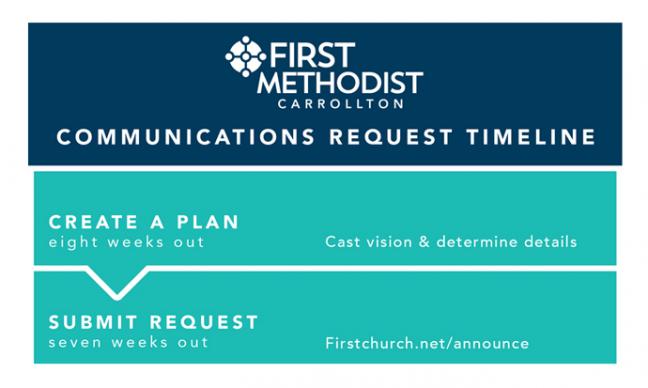By Dan Wunderlich
Collecting and organizing communications requests can be tricky, even in a small church. Whether you're dealing with requests for announcements, graphics, slides, videos, changes to the website, social media posts or a thousand other things, it is easy to get overwhelmed.
The last thing you want to do is agree to make an announcement or design a flyer and then forget. And we all know how unhelpful it is when someone asks you to make an announcement five minutes before the service, leaves a note in a place that you don't check or asks for something to be put in the bulletin five minutes after the final copy is printed.
What helps many churches and church communicators get a handle on the chaos is a communications request form. Using tools that are either free or already included in your website builder, you can have an effective and easy-to-use form in no time.
Setting the expectations
Having a form submission system will help you gather and organize the requests. However, it can be immensely helpful first to set the expectations for communications requests. Some areas to consider include:
- What types of announcements are made through which channels (pulpit, bulletin, social media, etc.)?
- What types of announcements will not be made through certain channels?
- How long does it take to produce various items (graphics, slides, printed pieces, videos, etc.)?
- What are the deadlines for submitting requests?
- Who can make a request?
With clear answers to these questions, you can begin to build a system that works within your limits and abilities or those of your team. Including key expectations, such as deadlines, in writing at the top of the form will help you if you ever need to decline or modify a request due to non-compliance.
Choosing a form builder
There are many options when it comes to form builders. If you have a WordPress website, you may have a form-builder included, or you can use one of the many free plugins. Squarespace includes a form-builder with its websites.
You can also use dedicated form builders, including the free Google Forms and services like WuFooor Typeform, which both have free and paid levels. You can embed forms from these services within a page on your website. If you don't have a website but still wish to use a digital form, these services can host and provide direct links to the form.
- Name
- Email or phone number
- Announcement or project title
- Announcement or project description
- Due date
If you'd like more details, you might include checkboxes for channel options (pulpit, bulletin, social media, etc.) or questions about the goals and target audience for the project.
If you have a bigger or more complex ministry, you might add a few more variables, such as ministry or department name and budget information.
It is also a good idea to include an "I don't know what this should look like" option. This can take some of the pressure off of the person requesting an announcement or designed piece and allow you to work with them to create something you think will be effective.
Keep the length and complexity of the form reasonable. The longer the form, the higher the chance users will feel that it's a hassle to complete. Consider creating different forms for different types of projects, for announcements versus a graphic design or video request. If you're relatively comfortable with your form builder, explore the use of conditional questions or sections, which ensure that, based on the answers, only relevant sections of the form are displayed.
To see a sample form, check out this communications request form from First Methodist Carrollton.
Notifications
Important to the process is being notified when new forms are submitted. Many form builders include email notifications. They can be enabled for Google Forms through free add-ons.
If you'd like to get a little more advanced, you can create a free account with Zapier, which is a service that connects apps with one another. Zapier interfaces with many form builders, as well as many to-do list and project management apps. For example, you can have new Google Forms submissions turned into to-do list items within apps like Trello, Airtable or Asana.
Stick to the system
Even though you've set the expectations, forms and notifications, it doesn't become a true system until you start to use it. Be clear in communication with leaders and volunteers how you expect the system to work. Share the deadlines, walk them through the form and answer any questions they have.
Be open to suggestions that will make the process easier for the people who have to use it. If it is difficult for them to use, they are likely to look for ways around it.
At the same time, stick to the system. If you start to bend deadlines for some, others will either expect the same treatment or or may display resentment. When people call, email, text or drop by your office with a request, respond with something like, "I would love to work on that for you. If you will fill out the communications request form, that helps centralize everything in one place and gives me everything I need to get started and not forget about it. Thanks!"
If you set clear expectations, design a user-friendly form, follow-through on your responsibilities and offer positive reinforcement to your leaders and volunteers for using the system properly, you can cut out much of the pain associated with communications requests in your church.
<div noprint"="">
Rev. Dan Wunderlich is an extension minister focused on worship, communication, and creativity with the goal of helping ministries and their leaders better connect with their communities. Find out more about his work and his podcast "Art of the Sermon" atDefiningGrace.com.

